
Применение углеродных нанотрубок в биомедицине 2 / Qian, P., Qin, Y., Lyu, Y., Li, Y., Wang, L., Wang, S., & Liu, Y. (2019). A hierarchical cobaltcarbon nanotube hybrid nanocomplex-based ratiometric fluorescent nanosensor for ultrasensitive detection of hydrogen peroxide and glucose
.pdf
Analytical and Bioanalytical Chemistry https://doi.org/10.1007/s00216-019-01573-z
RESEARCH PAPER
A hierarchical cobalt/carbon nanotube hybrid nanocomplex-based ratiometric fluorescent nanosensor for ultrasensitive detection
of hydrogen peroxide and glucose in human serum
Pengcheng Qian1 & Yingnan Qin2 & Yanlong Lyu1 & Yunfei Li1 & Lei Wang2 & Shuo Wang3 & Yaqing Liu1
Received: 18 August 2018 / Revised: 22 November 2018 / Accepted: 31 December 2018
# Springer-Verlag GmbH Germany, part of Springer Nature 2019
Abstract
Highly sensitive detection of H2O2 and glucose is critical for fundamental research and disease diagnosis. A ratiometric sensor can simultaneously afford two readout signals that provide an internally normalized response to change, thereby reducing false results and improving detection accuracy. A novel ratiometric fluorescent nanosensor for ultrasensitive detection of hydrogen peroxide and glucose was constructed on the basis of the peroxidase-like properties of a hierarchical cobalt/carbon nanotube hybrid nanocomplex (Co-CNT). The as-prepared Co-CNT catalyzes the transformation of the non-fluorescent Amplex Red (AR) into a fluorescent derivative and the transformation of fluorescent scopoletin (SC) into a non-fluorescent derivative in the presence of H2O2. The sensing system changes colour from yellow to blue, which can be clearly seen with the naked eye. With the fluorescence ratio of AR to SC as readout, the detection limit of H2O2 reaches as low as 100 nM. The developed assay is further utilized for determining H2O2-related oxidase reactions with the glucose and glucose oxidase system as model. Glucose can be selectively and sensitively detected as low as 150 nM. Satisfactory recoveries are obtained for glucose detection in serum samples. The developed assay is simple in terms of preparation and operation and provides a straightforward method for costeffective and reliable detection of H2O2 and H2O2-related reactions in clinical diagnosis and biomedical applications.
Keywords Ratiometric nanosensor . Fluorescent biosensor . Enzyme-free . Label-free . Glucose
Pengcheng Qian and Yingnan Qin contributed equally to this work.
Electronic supplementary material The online version of this article (https://doi.org/10.1007/s00216-019-01573-z) contains supplementary material, which is available to authorized users.
*Shuo Wang wangshuo@nankai.edu.cn
*Yaqing Liu yaqingliu@tust.edu.cn
1State Key Laboratory of Food Nutrition and Safety, Key Laboratory of Food Nutrition and Safety (Ministry of Education), College of Food Engineering and Biotechnology, Tianjin University of Science and Technology, Tianjin 300457, China
2College of Chemistry and Molecular Engineering, Qingdao University of Science and Technology, Qingdao 266042, China
3Tianjin Key Laboratory of Food Science and Health, School of Medicine, Nankai University, Tianjin 300071, China
Introduction
As an important biochemical substrate, hydrogen peroxide (H2O2) is involved in many pathways related to cell differentiation, proliferation and disease progression [1, 2] and plays key roles in biological systems, biomedicine and other fields [3]. Excessive accumulation of H2O2 causes diverse serious diseases including cancers [4]. It is well known that H2O2 can be generated via many oxidase enzyme-related reactions and is an important member of the reactive oxygen species in biologic systems [5]. For example, H2O2 is a by-product of the oxidation of glucose by glucose oxidase (GOx), which is one major energy source and implements critical functions in biological systems. Abnormally high levels of glucose indicate a high probability of diabetes and can be monitored via H2O2 detection [6–8]. Therefore, it is of significant importance to develop sensitive assays for determination of both H2O2 and glucose for fundamental research and disease diagnosis.

Qian P. et al.
Enzyme-based detection assays for H2O2 have been widely developed owing to their high specificity and efficiency [9]. However, enzymes are usually expensive and unstable for long-term storage. Therefore, considerable efforts have been devoted to develop nanomaterial-related assays for H2O2 determination, such as metal-organic frameworks (MOFs) [10–12], single-wall carbon nanotubes [13–15], bimetallic alloy nanomaterials [16–19], DNA-templated silver nanoclusters [20], upconversion nanoparticles [21, 22] and cerium-based nanomaterials [9, 23, 24]. Such investigations provide alternative assays for reducing the cost and environmental interference. Among the developed assays, fluorescent techniques have been attracted ever-increasing attention owing to their high sensitivity and simple operation [1, 25, 26]. However, it worth noting that most fluorescent strategies are developed with a single fluorescent probe as signal indicator. Detection assays that function according to either signal Bturnon^ or Bturn-off^ might lead to false positive or false negative results. A ratiometric fluorescent sensor can simultaneously afford two readout signals modulated by the target substrate, presenting a built-in correction function [27]. This endows the ratiometric sensor with the capability to reduce false results and thus improve detection accuracy. However, only a few ratiometric biosensors have been developed for determination of both H2O2 and glucose [1, 28–31].
Very recently, cobalt-based nanomaterials were reported as excellent catalysts for oxygen reduction reactions and oxygen evolution reactions [32–34]. Considering their outstanding catalysis capability, it is expected that the cobalt-based nanomaterials have great potential for biosensing applications. In our investigation, we for the first time found that a hierarchical cobalt/carbon nanotube hybrid nanocomplex (CoCNT), prepared by using MOFs of ZIF-67 as precursors, exhibits excellent peroxidase-like properties and can not only significantly quench the fluorescence of scopoletin (SC) but also transform the non-fluorescent Amplex Red (AR) into its fluorescent derivative with high fluorescence response via oxidation in the presence of H2O2. The intrinsic catalytic activity of Co-CNT allows it to act as useful building block for the development of ratiometric fluorescent nanosensors for H2O2. Furthermore, based on the production of H2O2 from glucose via catalysis by GOx, this strategy also provides a novel method for ratiometric sensing of glucose. The detection strategy provides a straightforward method for construction of ratiometric nanosensors to improve detection accuracy.
Experimental section
Materials and chemicals
KCl, CaCl2, Cu(NO3)2, lysine (Lys), methionine (Met), glycine (Gly), glucose and H2O2 were obtained from Sinopharm
Chemical Reagent Co., Ltd. Glucose oxidase (GOx), Amplex Red (AR) and scopoletin (SC) were purchased from SigmaAldrich Co., Ltd. BSA was obtained from Beijing Solarbio Science & Technology Co., Ltd. Co(NO3)2 and 2- methylimidazole were obtained from Shanghai Macklin Biochemical Co., Ltd. All reagents were of analytical grade and used without further purification. All solutions were prepared with ultrapure water (18.2 MΩ cm) obtained from a Milli-Q purification system. Fetal bovine serum was purchased from Scitecher and had been filtered (0.1 mm) by the manufacturer prior to purchase.
Apparatus
The morphology of Co-CNT was obtained using field emission scanning electron microscopy (SEM) (FESEM, JEOL, JSM-670IF). Fluorescence spectra were recorded with a LUMINA fluorescence spectrometer (Thermo, USA). X-ray photoelectron spectroscopy (XPS) analyses were conducted on an ESCALAB-MKII spectrometer (VG Co., U.K.) with Al K X-ray radiation as the X-ray source for excitation.
Synthesis of hierarchical cobalt/carbon nanotube hybrid nanocomplex (Co-CNT)
Co-CNT was prepared using ZIF-67 MOFs as precursor materials according to a previous report [35] with slight modification. 2-Methylimidazole (4.9266 g) was dissolved in 50 mL methanol and Co(NO3)2·6H2O (4.3655 g) was dissolved in 150 mL methanol. These two solutions were then mixed together and kept for 24 h at room temperature. The purple precipitate was collected by centrifugation and then washed several times with ethanol. The product was dried under vacuum for 24 h. The ZIF-67 particles were dispersed in a ceramic boat, heated to 350 °C, maintained for 1.5 h, and then the temperature was raised to 700 °C for 3.5 h at a heating rate of 2 °C /min under an atmosphere of N2/H2 (90%/10% volume ratio). After that, the furnace was cooled down to room temperature gradually.
Fluorescent detection of H2O2
The sensing platform was prepared by mixing AR (1.0 μM) and SC (2.5 μM) with the as-prepared Co-CNT (final concentration of 0.9 μg/mL) in Tris-HCl buffer (25 mM, pH 8.0). H2O2 was added into the sensing platform and the resulting solution was incubated at 25 °C for 5 h. The fluorescence spectra of AR (λex = 540 nm) and SC (λex = 370 nm) were then measured. The excitation wavelengths were selected by monitoring the fluorescence spectra of AR and SC at different excitation wavelengths (see Electronic Supplementary Material (ESM) Fig. S1). The excitation slit width was set as 5 nm (see ESM Fig. S2).
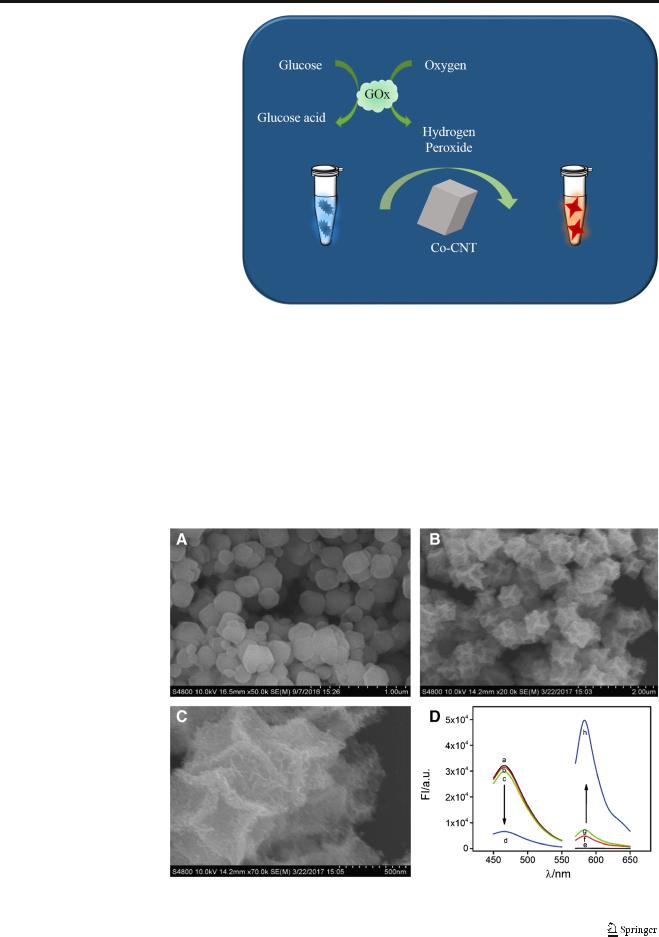
A hierarchical cobalt/carbon nanotube hybrid nanocomplex-based ratiometric fluorescent nanosensor for...
Scheme 1 Schematic of Co- CNT-based fluorescent nanosensor for ratiometric detection of H2O2 and glucose
Fluorescent detection of glucose
For the detection of glucose, GOx (4.0 μL, 1.0 mg/mL) and glucose (20 μL) with different concentrations were incubated at 37 °C for 1 h (Tris-HCl buffer solution, 144 μL, 25 mM, pH 8.0) and then transferred into the as-prepared sensing platform. After incubation at 25 °C for 5 h, the fluorescence spectra of SC and AR were recorded. For the detection of glucose in serum samples, glucose with different concentration was added into diluted serum samples. The determination followed the same procedure as that described above.
Fig. 1 SEM images of ZIF-67 nanoparticles (A), Co-CNT with scale bar of 2.0 μm (B) and 500 nm (C). (D) Fluorescence
spectra of SC (a), SC + H2O2 (b), SC + Co-CNT (c), SC + H2O2 + Co-CNT (d), AR (e), AR + H2O2 (f), AR + Co-CNT (g), AR + H2O2 + Co-CNT (h)
Selectivity
Taking the complex environment into consideration, we selected the following interfering substances comprising mainly natural amino acids, small molecules and metal ions with physiological concentrations: glucose (0.1 mM), glycine (Gly), methionine (Met), lysine (Lys), galactose, maltose, fructose, sucrose, BSA, calcium ions (Ca2+), potassium ions (K+), magnesium ions (Mg2+), and copper ions (Cu2+). The interfering substances were all 1.0 mM except BSA (0.1 mg/mL). After incubation
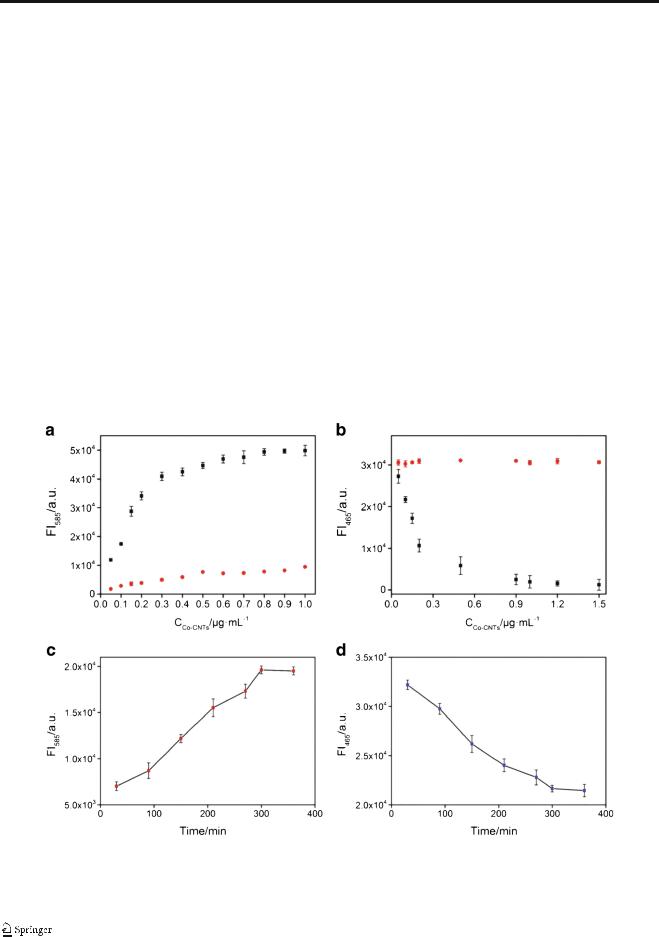
Qian P. et al.
with the sensing system, the fluorescence responses were measured via fluorescence spectrophotometry.
Pretreatment of serum sample
Serum was centrifuged for 5 min (6000 rpm), then separated and diluted into an appropriate concentration with ultrapure water.
Results and discussion
Detection principle and feasibility for H2O2 detection
The developed ratiometric assay is based on the peroxidaselike property of Co-CNT, which can convert the fluorescent SC into a non-fluorescent derivative and the non-fluorescent AR into a fluorescent derivative as illustrated in Scheme 1. The Co-CNT was prepared by following a previous report with slight modification [35]. As illustrated in Fig. 1, the polyhedral structure of the as-prepared ZIF-67 nanoparticles (A) is well retained after thermal treatment in the presence of Co(NO3)2 while the surface becomes much rougher (B).
Open voids are monitored from the amplified image (C), indicating the formation of cobalt–carbon nanotube with hollow structures. XPS experiments were further conducted to monitor the chemical composition of the Co-CNT (see ESM Fig. S3). Fluorescent spectra were recorded to validate the feasibility of the developed assay (Fig. 1D); the maximum fluorescence of SC is found at 465 nm (a). The presence of either H2O2 (b) or Co-CNT (c) has negligible influence on the fluorescent responses of SC, which only can be significantly quenched once H2O2 and Co-CNT coexist in the sensing system (d). The other signal probe AR is not fluorescent (e) and presents only dim fluorescence in the presence of H2O2 (f) or Co-CNT (g). The coexistence of H2O2 and Co-CNT outstandingly augments the fluorescent response of AR (h). The results validate the efficient peroxidase-like activity of Co-CNT towards SC and AR in the presence of H2O2. If the concentration of Co-CNT is fixed, the signal changes of SC and AR would be related to the concentration of H2O2. According to the inverse fluorescent responses of AR and SC, therefore, a ratiometric fluorescent sensor for H2O2 and glucose detection was successfully constructed with the ratio of fluorescence intensity of AR at 585 nm to that of SC at 465 nm, FI585/ FI465, as the readout.
Fig. 2 (a) FI585 of AR and Co-CNT with different concentrations in the
presence (black) and absence (red) of H2O2. (b) FI465 of SC and Co-CNT with different concentrations in the presence (black) and absence (red) of
H2O2. (c) FI585 of AR in the presence of Co-CNT and H2O2 versus
reaction time. (d) FI465 of SC in the presence of Co-CNT and H2O2 versus reaction time. The error bars were obtained according to three indepen-
dent experimental results
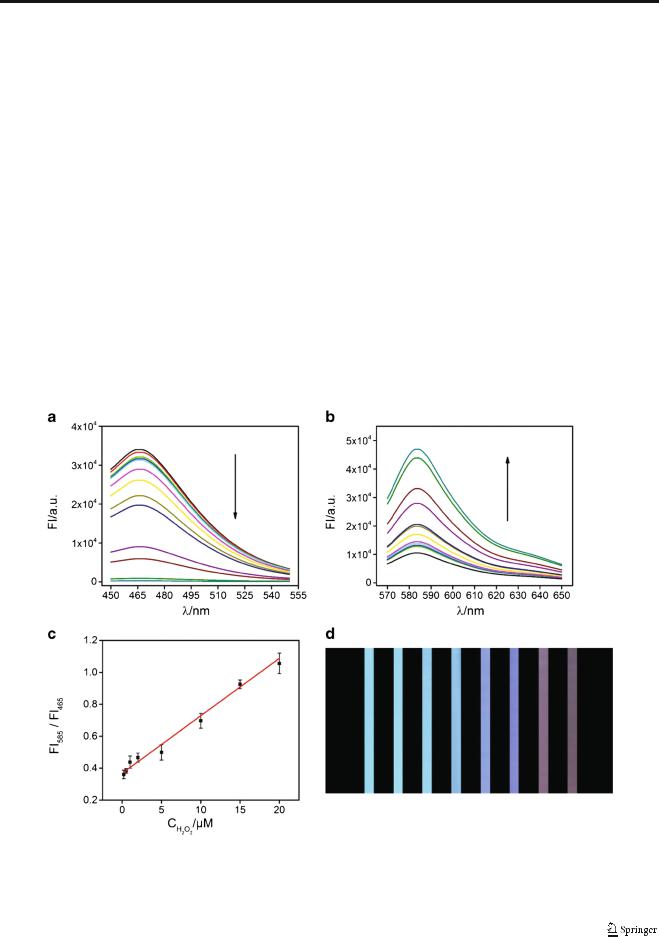
A hierarchical cobalt/carbon nanotube hybrid nanocomplex-based ratiometric fluorescent nanosensor for...
Optimization of experimental conditions
To acquire high performance of the developed sensing system, the concentration of Co-CNT and incubation time were optimized by monitoring the signal change of AR and SC (Fig. 2). As mentioned above, Co-CNT can oxidize AR to present dim fluorescence in the absence of H2O2; thus, the concentration of Co-CNT was optimized by comparing the change in fluorescence of AR in the absence and presence of H2O2 (A). With increasing concentration of Co-CNT, the fluorescence of the AR solution is slightly enhanced in the absence of H2O2, but the fluorescence is outstandingly augmented in the presence of H2O2. A maximum fluorescence enhancement is found when the Co-CNT concentration reaches 0.9 μg/mL. For the fluorescence probe SC, no obvious change is found with CoCNT concentration in the absence of H2O2. Under the assistance of H2O2, the fluorescence of SC is significantly depressed and reached a plateau if the concentration of CoCNT is higher than 0.9 μg/mL (B). Thus, 0.9 μg/mL of CoCNT is used in the following experiments. The incubation time was optimized by monitoring the fluorescence change
of AR (FI585) and SC (FI465) at 25 °C (Fig. 2C). It was found that the maximum fluorescent intensity for AR and the minimum fluorescent intensity for SC were reached after 5 h. The incubation time for reaching maximum signal change at different temperature was further explored (see ESM Fig. S4). The FI585/FI485 of the sensing system reaches a maximum after incubation for 300 min when keeping the reaction at 25 °C (a), which is slightly shortened to 270 min at 37 °C
(b). When the temperature raises to 45 °C, the reaction time for reaching the maximum of FI585/FI485 reduces to 210 min
(c). However, the reaction time extends to 300 min again to reaching the maximum of FI585/FI485 when the reaction temperature raises to 60 °C. It is considered that H2O2 is prone to decomposition at high temperature, which may inhibit the reactions between the Co-CNT and AR and SC. According to the above results, though the required incubation time at 45 °C is the shortest, that temperature is not suitable for potential application to in vivo detection and not convenient for in situ detection. Meanwhile, since the required incubation time at 25 °C is close to that at 37 °C, 25 °C is selected for the following investigation.
Fig. 3 Fluorescence spectra of the Co-CNT-based nanosensor, SC (a) and AR (b), versus H2O2 concentrations, 0, 0.2, 0.5, 1.0, 2.0, 5.0, 10, 15, 20,
40, 50, 80, 100 μM. (c) Linear relationship of FI585/FI465 versus H2O2 concentrations. The error bars were obtained via three independent
experiments. (d) Photos of the sensing system at different H2O2 concentration under UVexcitation. The concentrations of H2O2 from left to right are 0, 0.5, 10, 20, 40, 50, 80 and 100 μM
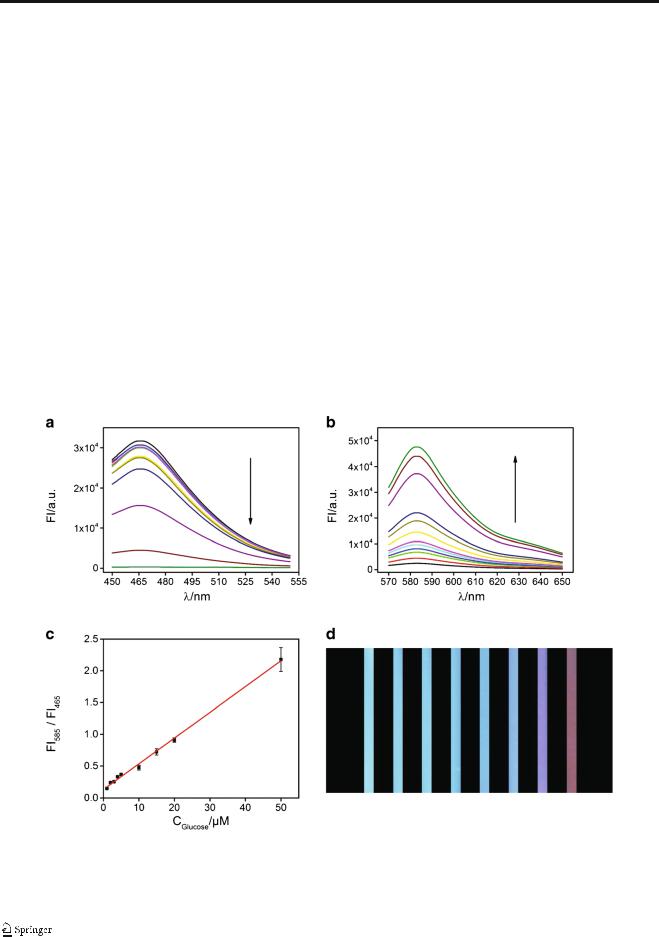
Qian P. et al.
Sensitivity of developed sensing system for H2O2 and glucose
Under the optimal experimental conditions, the sensitivity of the developed ratiometric fluorescent assay was evaluated by monitoring the fluorescence response of the sensing system as a function of H2O2 concentration (Fig. 3). As the concentration of H2O2 increased, FI465 of SC decreased (Fig. 3A) while the FI585 of AR increased (Fig. 3B). With the developed ratiometric fluorescent nanosensor, a linear range of FI585/ FI465 versus H2O2 concentration is found over three orders of magnitude from 0.2 to 20 μM (R2 = 0.989), Fig. 3C. The limit of detection (LOD) is estimated as 100 nM according to the calculation of three times the signal to noise ratio, which is comparable or better than most previous reports for H2O2 detection [36–38] (see ESM Table S1). Under UV excitation, the sensing system exhibits blue fluorescence before adding H2O2; the colour gradually changes to red with increasing concentration of H2O2, providing an interesting method for visual detection. Furthermore, a linear range from 0.2 to 20 μM for H2O2 detection in serum is obtained according to the as-developed assay, validating its potential application in biological environments (see ESM Fig. S5).
It is well known that many biological substrates including a large variety of metabolites in the human body can be oxidized by their specific oxidoreductases to produce H2O2, such as cholesterol oxidase to cholesterol, glucose oxidase (GOx) to glucose, and acetylcholinesterase/choline oxidase to acetylcholine. Given the developed sensor performance, such a sensitive response of Co-CNT toward H2O2 provides a universal platform to detect substrates involving H2O2-generation reactions for biomedical applications. As a proof-of-concept demonstration, glucose was chosen as the model to validate the feasibility. The presence of either glucose or GOx has no significant influence on the fluorescent response of AR and SC since no H2O2 is generated in these cases. After the GOx concentration was optimized (see ESM Fig. S6), the detection for glucose was conducted by addition of the corresponding GOx to the sensing system. In this case, H2O2 is generated in situ as a result of the catalytic activity of GOx on glucose. With addition of glucose, the fluorescence response of SC is decreased (Fig. 4A) while the fluorescence response of AR is enhanced (Fig. 4B). The FI585/FI465 linearly dependds on the glucose concentration within range from 1.0 μM to 50 μM (R2 = 0.999), Fig. 4C. The LOD of 150 nM for glucose is obtained according to the calculation of three times the signal
Fig. 4 Fluorescence spectra of the Co-CNT-based nanosensor, SC (a) and AR (b), at different concentrations of glucose: 0, 1, 2, 3, 4, 5, 10, 15, 20, 50, 100, 200 μM. (c) Linear relationship of FI585/FI465 versus glucose concentrations from 1.0 μM to 50 μM. The error bars were obtained via
three independent experiments. (d) Photos of the sensing system at different concentrations of glucose under UVexcitation. The concentrations of glucose from left to right are 0, 2.0, 4.0, 5.0, 10, 50, 100 and 200 μM
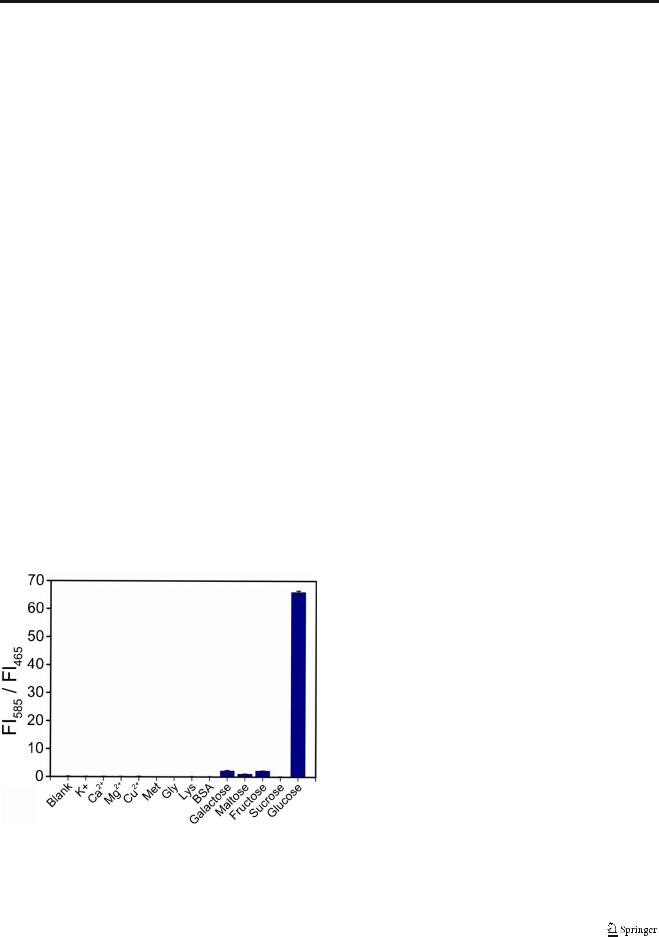
A hierarchical cobalt/carbon nanotube hybrid nanocomplex-based ratiometric fluorescent nanosensor for...
to noise ratio, which is comparable or better than most reports for glucose detection (see ESM Table S2). Similar to the H2O2 detection, the fluorescence colour of the sensing system changes from blue to red with addition of glucose under UV excitation (Fig. 4D).
Specificity of developed sensing system
High specificity is crucial especially in real sample detection. To evaluate the specificity, the fluorescent response of the sensing system was monitored after adding a diverse range of possible interferences including metal ions, proteins, amino acids and sugars (Fig. 5). Obviously, only glucose causes obvious change of FI585/FI465. The other additives did not result in obvious fluorescent signal change, even at concentrations ten times that of glucose, which is ascribed to the specificity of the catalysis by GOx toward glucose. The results indicate the excellent selectivity of the developed assay.
Feasibility for glucose detection in real samples
The potential application of the provided assay in real biological samples was further explored by detecting glucose in serum samples according to the same procedure as discussed above. Glucose detection in serum was first conducted with a glucometer. Considering that the developed nanosensor presents excellent sensitivity, the serum sample was diluted to allow for detection with the proposed assay. The results obtained with the developed assay are comparable with those measured with the glucometer. The feasibility of glucose detection in real samples was further explored by spiking a certain amount of glucose into the diluted serum samples. The
Fig. 5 Selectivity of the Co-CNT-based nanosensor for glucose. The concentration of glucose is 0.1 mM. The concentrations of metal ions, amino acids and other saccharides were 1.0 mM, and the concentration of BSA was 0.1 mg/mL. Error bars were obtained according to three independent experiments
recoveries are found to be within a narrow range from 93.3% to 105.0% (see ESM Table S3). The results validate that the developed Co-CNT-based sensing platform is feasible for glucose detection in biological samples.
Conclusion
A novel ratiometric fluorescent sensor for H2O2 and glucose has been successfully constructed on the basis of excellent peroxidase-like properties of the as-prepared Co-CNT, which can simultaneously oxidize non-fluorescent Amplex Red into a fluorescent derivative and the fluorescent scopoletin into a non-fluorescent derivative in the presence of H2O2. The developed sensing system presents excellent sensitivity and can detect H2O2 and glucose as low as 100 nM and 150 nM, respectively. The sensing system changes colour from blue to red with increasing concentration of H2O2 or glucose under UV excitation. The developed strategy is label-free and en- zyme-free, providing a convenient method that is simple in terms of preparation and operation. The investigation provides a straightforward assay for cost-effective and sensitive detection of H2O2 and H2O2-related reactions, presenting significant potential application in clinical diagnosis and biomedical applications.
Acknowledgements This work is supported by the National Natural Science Foundation of China (No. 21575138 and No. 21775108).
Compliance with ethical standards
Conflict of interest The authors declare that they have no competing interests.
Publisher’s note Springer Nature remains neutral with regard to jurisdictional claims in published maps and institutional affiliations.
References
1.Liu JW, Luo Y, Wang YM, Duan LY, Jiang JH, Yu RQ. Graphitic carbon nitride nanosheets-based ratiometric fluorescent probe for
highly sensitive detection of H2O2 and glucose. ACS Appl Mater Interfaces. 2016;8:33439–45.
2.Giorgio M, Trinei M, Migliaccio E, Pelicci PG. Hydrogen peroxide: a metabolic by-product or a common mediator of ageing signals? Nat Rev Mol Cell Bio. 2007;8:722–8.
3.Ju J, Chen W. In situ growth of surfactant-free gold nanoparticles on nitrogen-doped graphene quantum dots for electrochemical detection of hydrogen peroxide in biological environments. Anal Chem. 2015;87:1903–10.
4.Finkel T, Serrano M, Blasco MA. The common biology of cancer and ageing. Nature. 2007;448:767–74.
5.Liu B, Sun Z, Huang PJJ, Liu J. Hydrogen peroxide displacing DNA from nanoceria: mechanism and detection of glucose in serum. J Am Chem Soc. 2015;137:1290–5.

Qian P. et al.
6.Hu X, Yu J, Qian C, Lu Y, Kahkoska AR, Xie Z, et al. H2O2- responsive vesicles integrated with transcutaneous patches for glucose-mediated insulin delivery. ACS Nano. 2017;11:613–20.
7.Yu J, Qian C, Zhang Y, Cui Z, Zhu Y, Shen Q, et al. Hypoxia and
H2O2 dual-sensitive vesicles for enhanced glucose-responsive insulin delivery. Nano Lett. 2017;17:733–9.
8.Zhang Y, Wang J, Yu J, Wen D, Kahkoska AR, Lu Y, et al.
Bioresponsive microneedles with a sheath structure for H2O2 and pH cascade-triggered insulin delivery. Small. 2018;14:1704181.
9.Zeng HH, Qiu WB, Zhang L, Liang RP, Qiu JD. Lanthanide coordination polymer nanoparticles as an excellent artificial peroxidase for hydrogen peroxide detection. Anal Chem. 2016;88:6342–8.
10.Feng D, Gu ZY, Li JR, Jiang HL, Wei Z, Zhou HC. Zirconiummetalloporphyrin PCN-222: mesoporous metal-organic frameworks with ultrahigh stability as biomimetic catalysts. Angew Chem Int Ed. 2012;51:10307–10.
11.Xiong Y, Chen S, Ye F, Su L, Zhang C, Shen S, et al. Synthesis of a mixed valence state Ce-MOF as an oxidase mimetic for the colorimetric detection of biothiols. Chem Commun. 2015;51:4635–8.
12.Wang Q, Zhang L, Shang C, Zhang Z, Dong S. Triple-enzyme mimetic activity of nickel–palladium hollow nanoparticles and their application in colorimetric biosensing of glucose. Chem Commun. 2016;52:5410–3.
13.Zhang Y, Xu C, Li B, Li Y. In situ growth of positively-charged gold nanoparticles on single-walled carbon nanotubes as a highly active peroxidase mimetic and its application in biosensing. Biosens Bioelectron. 2013;43:205–10.
14.Baghayeri M, Amiri A, Farhadi S. Development of non-enzymatic glucose sensor based on efficient loading ag nanoparticles on functionalized carbon nanotubes. Sens Actuator B Chem. 2016;225: 354–62.
15.Fu S, Fan G, Yang L, Li F. Non-enzymatic glucose sensor based on au nanoparticles decorated ternary Ni-Al layered double hydroxide/ single-walled carbon nanotubes/graphene nanocomposite. Electrochim Acta. 2015;152:146–54.
16.Chen Y, Cao H, Shi W, Liu H, Huang Y. Fe–Co bimetallic alloy nanoparticles as a highly active peroxidase mimetic and its application in biosensing. Chem Commun. 2013;49:5013–5.
17.Lu C, Liu X, Li Y, Yu F, Tang L, Hu Y, et al. Multifunctional Janus hematite–silica nanoparticles: mimicking peroxidase-like activity and sensitive colorimetric detection of glucose. ACS Appl Mater Interfaces. 2015;7:15395–402.
18.Mei H, Wu W, Yu B, Wu H, Wang S, Xia Q. Nonenzymatic electrochemical sensor based on Fe@Pt core–shell nanoparticles for hydrogen peroxide, glucose and formaldehyde. Sens Actuator B Chem. 2016;223:68–75.
19.Li M, Liu L, Xiong Y, Liu X, Nsabimana A, Bo X, et al. Bimetallic MCo (M = Cu, Fe, Ni, and Mn) nanoparticles doped-carbon nanofibers synthetized by electrospinning for nonenzymatic glucose detection. Sens Actuator B Chem. 2015;207:614–22.
20.Xu Y, Chen Y, Yang N, Sun L, Li G. DNA-templated silver nanoclusters formation at gold electrode surface and its application to hydrogen peroxide detection. Chin J Chem. 2012;30:1962–5.
on fluorescence detection of H2O2 and glucose in blood. ACS Appl Mater Interfaces. 2015;7:10548–55.
23.Zhao H, Dong Y, Jiang P, Wang G, Zhang J. Highly dispersed CeO2 on TiO2 nanotube: a synergistic nanocomposite with superior peroxidase-like activity. ACS Appl Mater Interfaces. 2015;7: 6451–61.
24.Artiglia L, Agnoli S, Paganini MC, Cattelan M, Granozzi G. TiO2@CeOx core–shell nanoparticles as artificial enzymes with peroxidase-like activity. ACS Appl Mater Interfaces. 2014;6: 20130–6.
25.Ma Y, Cen Y, Sohail M, Xu G, Wei F, Shi M, et al. A ratiometric fluorescence universal platform based on N, Cu codoped carbon
dots to detect metabolites participating in H2O2-generation reactions. ACS Appl Mater Interfaces. 2017;9:33011–9.
26.Liu Y, Tu D, Zheng W, Lu L, You W, Zhou S, et al. A strategy for accurate detection of glucose in human serum and whole blood based on an upconversion nanoparticles-polydopamine nanosystem. Nano Res. 2018;11:3164–74.
27.Lu H, Xu S. Visualizing BPA by molecularly imprinted ratiometric fluorescence sensor based on dual emission nanoparticles. Biosens Bioelectron. 2017;92:147–53.
28.Liu F, Bing T, Shangguan D, Zhao M, Shao N. Ratiometric fluorescent biosensing of hydrogen peroxide and hydroxyl radical in living cells with lysozyme–silver nanoclusters: lysozyme as stabilizing ligand and fluorescence signal unit. Anal Chem. 2016;88: 10631–8.
29.Xu M, Han JM, Wang C, Yang X, Pei J, Zang L. Fluorescence ratiometric sensor for trace vapor detection of hydrogen peroxide. ACS Appl Mater Interfaces. 2014;6:8708–14.
30.Lei Y, Xue C, Zhang S, Sha Y. A ratiometric fluorescent probe for sensing hydrogen peroxide based on a hemicyanine–naphthol fluorophore. Luminescence. 2016;31:660–4.
31.Goggins S, Apsey EA, Mahon MF, Frost CG. Ratiometric electrochemical detection of hydrogen peroxide and glucose. Org Biomol Chem. 2017;15:2459–66.
32.Hou Y, Li J, Wen Z, Cui S, Yuan C, Chen J. Co3O4 nanoparticles embedded in nitrogen-doped porous carbon dodecahedrons with enhanced electrochemical properties for lithium storage and water splitting. Nano Energy. 2015;12:1–8.
33.Aijaz A, Masa J, Rösler C, Xia W, Weide P, Botz AJR, et al. Co@Co3O4 encapsulated in carbon nanotube-grafted nitrogendoped carbon polyhedra as an advanced bifunctional oxygen electrode. Angew Chem Int Ed. 2016;55:4087–91.
34.Huang ZF, Song J, Li K, Tahir M, Wang YT, Pan L, et al. Hollow cobalt-based bimetallic sulfide polyhedra for efficient all-pH-value electrochemical and photocatalytic hydrogen evolution. J Am Chem Soc. 2016;138:1359–65.
35.Xia BY, Yan Y, Li N, Wu HB, Lou XWD, Wang X. A metal– organic framework-derived bifunctional oxygen electrocatalyst. Nature Energy. 2016;1:15006.
36.Ryan TK, Jacky WY, ZhongáTang B. An AIE-active fluorescence turn-on bioprobe mediated by hydrogen-bonding interaction for highly sensitive detection of hydrogen peroxide and glucose. Chem Commun. 2016;52:10076–9.
21.Fan W, Bu W, Shen B, He Q, Cui Z, Liu Y, et al. Intelligent MnO2 37. Wen Y, Liu K, Yang H, Liu Y, Chen L, Liu Z, et al. Mitochondria-
nanosheets anchored with upconversion nanoprobes for concurrent pH-/H2O2-responsive UCL imaging and oxygen-elevated synergetic therapy. Adv Mater. 2015;27:4155–61.
22.Yuan J, Cen Y, Kong XJ, Wu S, Liu CL, Yu RQ, et al. MnO2- nanosheet-modified upconversion nanosystem for sensitive turn-
directed fluorescent probe for the detection of hydrogen peroxide near mitochondrial DNA. Anal Chem. 2015;87:10579–84.
38.Chang HC, Ho JAA. Gold nanocluster-assisted fluorescent detection for hydrogen peroxide and cholesterol based on the inner filter effect of gold nanoparticles. Anal Chem. 2015;87:10362–7.
